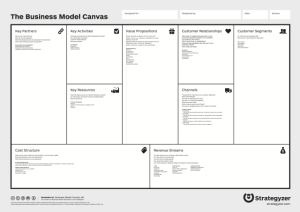“How do I turn my product or service idea into a viable business?” As a business coach and entrepreneur, it’s one of the questions I’m asked most often. While there is no one-size-fits-all answer, there are some very reliable methods and tools available to make the process of turning an idea into a business easier.
It’s a huge topic, a real elephant of a discussion, and over the next several articles I’ll be breaking it down into bite-sized pieces. I’ll introduce you to some of the ideas and techniques I’ve found to be the most effective for myself, my friends and my clients.

“Business Model Canvas” by Business Model Alchemist – http://www.businessmodelalchemist.com/tools. Licensed under CC BY-SA 1.0 via Wikimedia Commons – https://commons.wikimedia.org/wiki/File:Business_Model_Canvas.png#/media/File:Business_Model_Canvas.png
What makes an idea worth pursuing as a business? Ideas are the easy part. It’s the execution of that idea in the real world — how difficult it is to bring to life, and how the market responds to that idea — that will ultimately decide if it will succeed as a business. In other words, not every business idea is going to be a workable one.
The ideation process is where the rubber meets the road. For every great idea that has resulted in a successful business, there are thousands that have failed. As a friend of mine often says, “The road to startup failure is paved with good ideas.”
In order to have a chance at success, a business needs more than just a great idea. It needs an idea which results in a viable business model. You can have a great concept, but to succeed it has to lead to a defined and solid business model.
How do you validate a business idea? One of the best tools an entrepreneur can start with is something called the Business Model Canvas. It’s an idea that came out of the Lean Startup methodology created back in 2011 by Eric Ries. The Business Model Canvas serves as filter, allowing you to see how the idea translates into a real-world business context.
The Business Model Canvas breaks the core idea down into several pieces, resulting in a visual chart providing an overview of the business model. These sections are: Value Propositions; Customer Relationships; Channels; Customer Segments; Key Resources; Key Partners; Key Activities; Cost Structure; and Revenue Streams. These core elements are the fundamental building blocks of any business.
By putting your idea through the Business Model Canvas process, the ultimate long-term viability of the business will become much more clear. Holes in the business model will become evident, allowing you to rethink the model, and pivot the idea if necessary. It’s much easier to make big changes to your business idea that this stage, where your only cost is a fresh sheet of paper, than it is when your business has already launched and needs to change something fundamental to stay afloat.
It’s also important to note that this isn’t just for startups. It’s also used to stress test and improve existing businesses. It’s a powerful tool for improving an existing business model.
In the next several articles, I’ll dive more deeply into the business model canvas concepts, introduce the fundamentals of raising capital, and explain the basics of convertible notes.
I also covered this topic in depth on Episode 27 of the Success In Business Podcast. Click here to listen.
Do you have a question about your business? Tom would love to help you:
Leave a voicemail: (801) 228-0663
E-mail your questions: SuccessInBusinessPodcast@gmail.com
Follow this podcast on Twitter: @TomRyanSIBP
Get every episode free: Subscribe in iTunes
